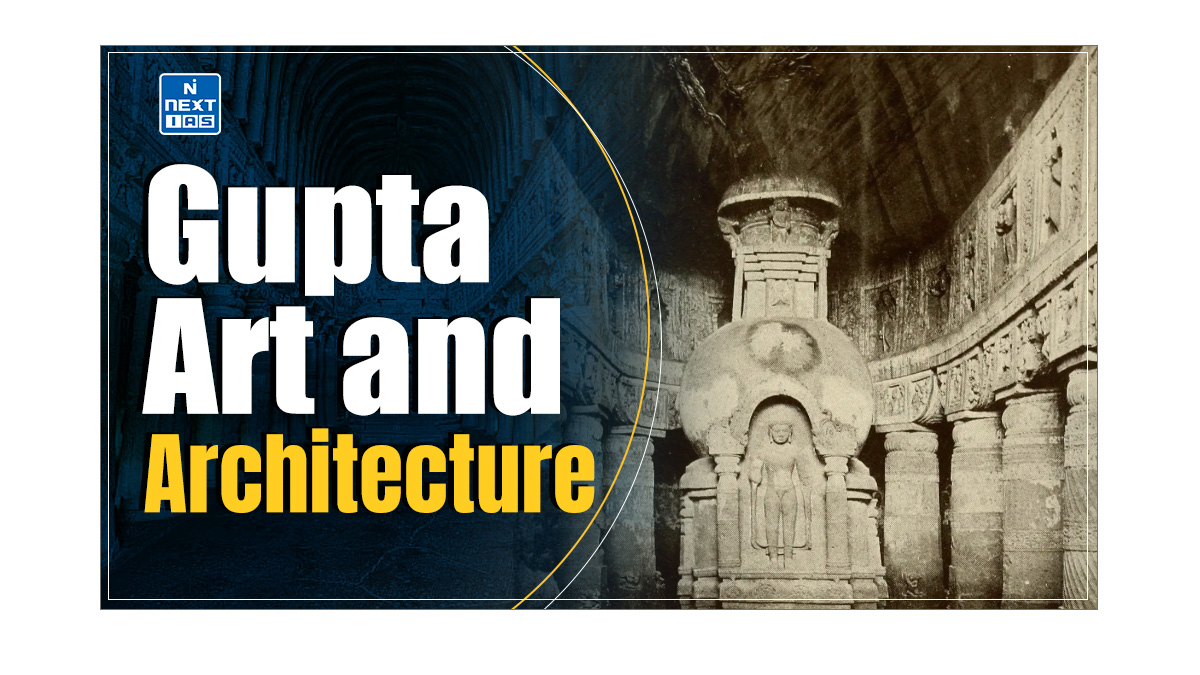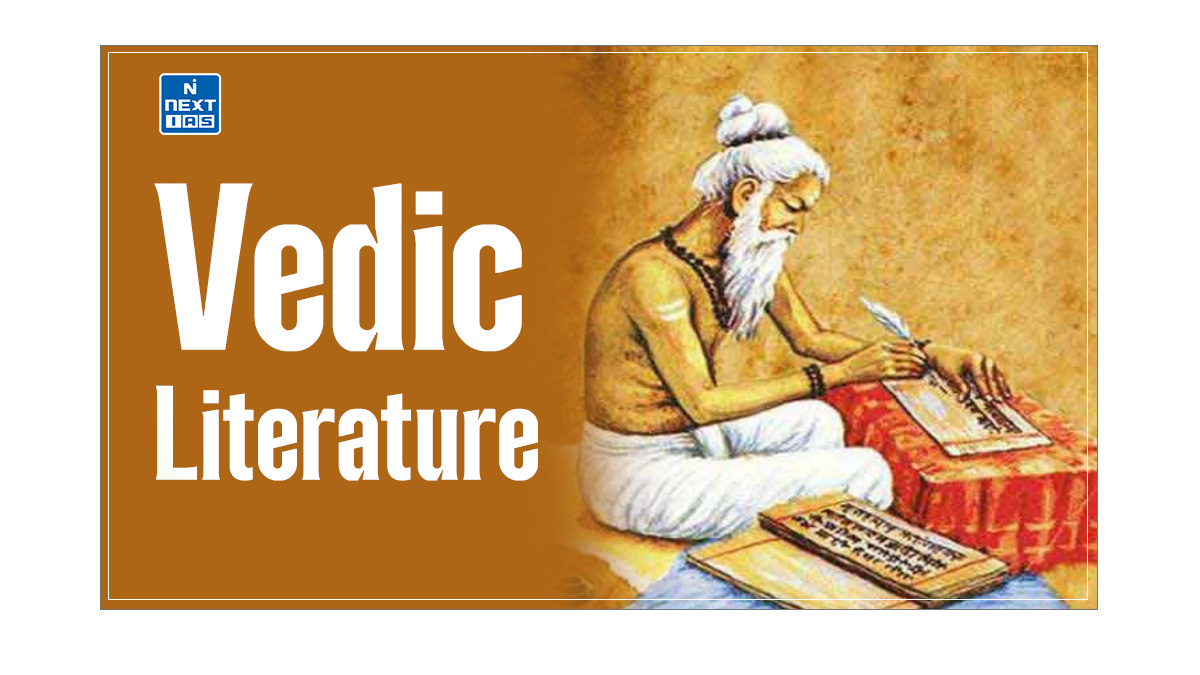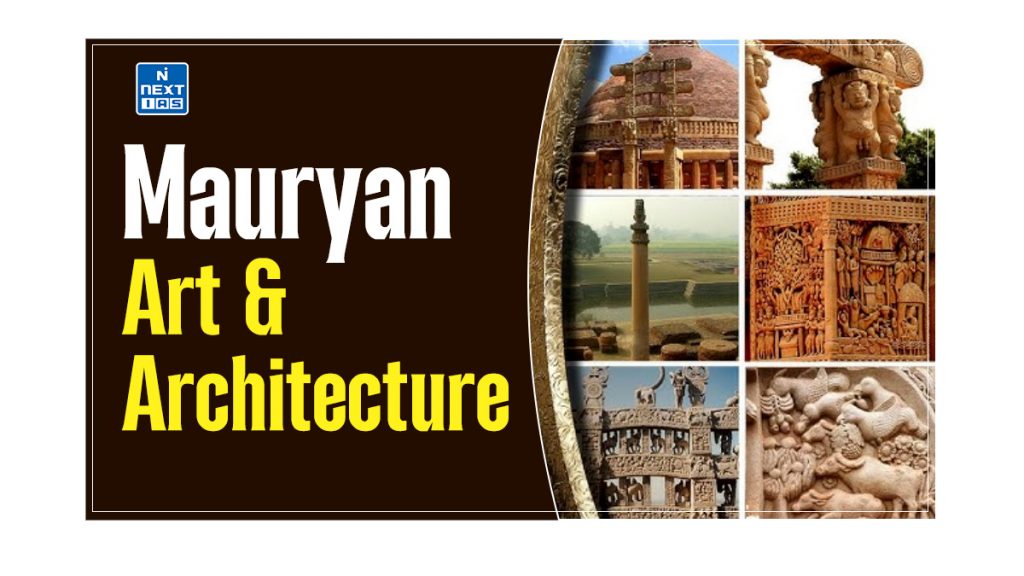
Mauryan Art and Architecture encompasses the diverse artistic and architectural achievements of the Mauryan Empire. Its significance lies in its profound impact on Indian art and architecture, setting a high standard for subsequent dynasties and reflecting the empire’s political, religious, and cultural values. This article aims to study in detail the major features, contributions, and lasting legacy of Mauryan art and architecture.
About Mauryan Empire
- The Mauryan Empire was a geographically extensive Iron Age historical power in ancient India, which was ruled by the Mauryan dynasty from 321 to 185 BCE.
- The empire originated from the kingdom of Magadha in the Indo-Gangetic plains (modern Bihar, eastern Uttar Pradesh, and Bengal) on the east side of the Indian subcontinent.
- Its capital city was Pataliputra (modern Patna).
- The empire was the largest ever in the Indian subcontinent and reached its zenith under Asoka.
Read our detailed article on the Mauryan Empire, Ashoka and Mauryan Administration.
Mauryan Art and Architecture
- The Mauryans made a remarkable contribution to art and architecture. They introduced stone masonry on a wide scale.
- Megasthenes stated that the Mauryan palace at Pataliputra was as splendid as the capital of Iran.
- Fragments of stone pillars and stumps, indicating the existence of 80 pillared halls, have been discovered at Kumrahar on the outskirts of modern-day Patna.
- The capitals of these pillars were realistically modelled and consisted of groups of animals.
- The finest extant example is that of Sarnath. It consists of four lions, which initially supported a dharma chakra.
- These rest on an abacus bearing an elephant, horse, bull, and lion in relief, separated by four minor chakras (with 24 spokes).
- Mauryan artisans attained high technical skills in polishing the stone pillars, which shined like northern black polished ware.
- Transporting the enormous stone blocks from the quarries and polishing and embellishing them when erected required a great feat of engineering.
- Each pillar is made of a single piece of buff-coloured sandstone. Only their capitals, beautiful sculptures of lions and bulls, are joined with the pillars on top.
- These polished pillars were set up throughout the country, which shows the technical knowledge involved in their polishing and transport had spread far and wide.
- Two free-standing stone figures—a Yaksha image from Parkham and a Yakshini sculpture from Besnagar—are the best examples of Indigenous art. A larger female is a perfect example of this style.
- The Mauryan artisans also started hewing caves from rocks for the monks to live in. The earliest example is the Barabar Caves, 30 km from Gaya. Later, this practice spread to western and southern India.
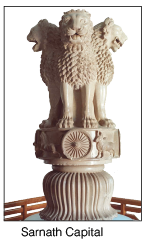
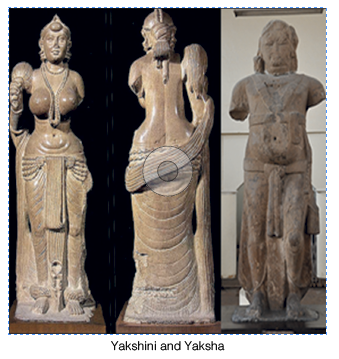
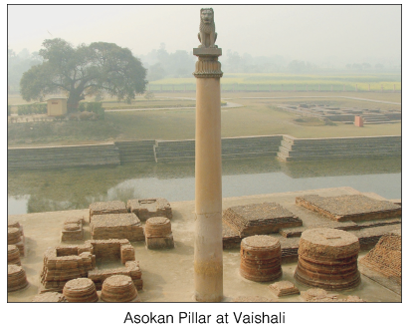
Features of Mauryan Art and Architecture
The significant features of the Mauryan Art and Architecture are as follows:
- Pillars of Ashoka: The Ashokan pillars are monumental columns erected by Emperor Ashoka across his empire. They showcase intricate designs and inscriptions that convey his Dhamma.
- Notable for their polished sandstone and lion capitals, such as the Sarnath Lion Capital, which now serves as India’s national emblem, these pillars reflect the influence of Greco-Persian architectural styles.
- The pillars were intended to mark important sites and propagate Ashoka’s messages of peace and Buddhism.
- Stupas: Stupas are dome-shaped structures that serve as repositories for relics and sacred objects, symbolising the Buddha’s presence.
- Mauryan stupas, including the famed Sanchi Stupa, were central to Buddhist worship and pilgrimage.
- The architectural design of these stupas emphasised their spiritual significance, as they served as focal points for meditation and communal rituals.
- Rock-cut Architecture: Mauryan rock-cut architecture includes early examples like the Barabar Caves, which were carved into solid rock and functioned as retreats for monks and places of worship.
- These caves are significant for their architectural innovation and simplicity, reflecting the Buddhist emphasis on meditation and asceticism.
- The rock-cut technique allowed for durable and monastic spaces, integral to religious practice during the Mauryan period.
Categories of Mauryan Art and Architecture
There are two categories of Mauryan Art and Architecture, which are as follows:
- Secular Architecture
- Religious Architecture
Both types have been discussed in detail in the following section.
Secular Mauryan Architecture
- Palaces: The Mauryan period saw the construction of elaborate royal palaces, with notable examples including the grand structures at Pataliputra.
- These palaces were characterised by their vast size, intricate design, and luxurious features, reflecting the empire’s wealth and sophistication.
- Fortifications: Mauryan fortifications included impressive walls and gates designed for defence.
- These fortifications were influenced by Persian and Achaemenid architectural styles, showcasing advanced military engineering and urban planning to protect the empire’s cities.
Religious Mauryan Architecture
- Stupas: The Great Stupa at Sanchi is a prime example of Mauryan religious architecture.
- These dome-shaped structures were built to house relics of the Buddha and served as focal points for Buddhist worship and pilgrimage.
- Chaityas and Viharas: Early Buddhist religious structures, such as chaityas (prayer halls) and viharas (monastic residences), were established during the Mauryan period.
- These structures provided spaces for meditation, communal activities, and monastic life.
- Monolithic Pillars: Ashoka’s monolithic pillars, with their inscriptions and symbolic carvings, are significant in Mauryan art. Made primarily from stone, these pillars were erected across the empire to disseminate Ashoka’s messages of Dhamma and Buddhism, reflecting both artistic and ideological aspects of Mauryan rule.
Sculpture in Mauryan Art and Architecture
Mauryan art and architecture sculpture is marked by its polished stone craftsmanship, exemplified by the lion and elephant capitals. These sculptures served both as decorative elements and symbols of imperial power. The prominent two have been discussed below.
Polished Stone Sculptures
- Mauryan sculpture is renowned for its polished stone carvings, including the lion and elephant capitals.
- These sculptures were characterised by their smooth surfaces and intricate details, showcasing the high craftsmanship achieved during this period.
- The lion capital from Sarnath is particularly notable for its grandeur and symbolic significance, representing power and authority.
Yaksha and Yakshi Statues
- Yaksha and Yakshi statues were important religious and fertility symbols during the Mauryan period.
- These figures, often depicted in naturalistic poses, were believed to embody prosperity and fertility.
- The Didarganj Yakshi is a prominent example, illustrating the fusion of artistic skill and religious symbolism.
- These statues reflected the influence of folk art and indigenous traditions, integrating local beliefs with broader religious practices.
Material Culture in Mauryan Art and Architecture
- The Mauryan conquest opened doors for trading and missionary activities. The contacts established by administrators, traders, Jaina, and Buddhist monks led to the spread of material culture in the Gangetic basin.
- Plenty of iron implements were used during Mauryas, including the spoked wheel.
- Although arms and weapons were the monopoly of the Maurayan state, the use of other iron tools was not restricted to any class.
- Burnt bricks were first used in northeastern India during the Mauryas. Mauryan constructions of brunt bricks have been found in Bihar and Uttar Pradesh.
- Houses were made of bricks and timber, which was plentiful because of the thick vegetation in ancient times. Magasthenese spoke of the wooden structure at the Mauryan capital, Pataliputra. Logs of wood were used to defend against floods and foreign invasions.
- Ring wells first appeared during Maurayan rule and spread to different parts of the country.
- Since ring wells supplied water to people for domestic use, it was no longer imperative to find settlements on the banks of rivers. Ring wells also served as soak pits in congested settlements.
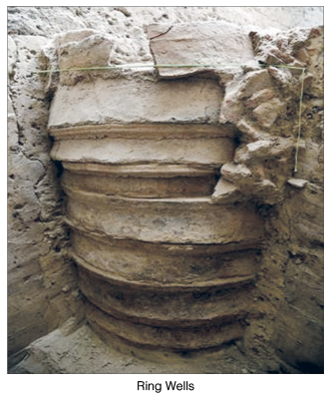
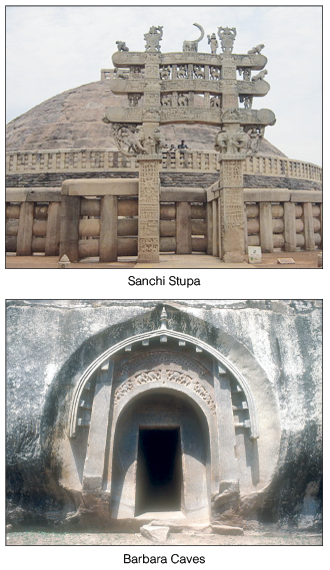
Ashoka’s Contribution to Mauryan Art and Architecture
Ashoka’s contribution to Mauryan art and architecture is profound, as he played a pivotal role in promoting Buddhist art and building monumental structures, which can be seen as follows:
- Role in Buddhist Art: Emperor Ashoka played a crucial role in developing and spreading Buddhist art and architecture.
- Ashoka promoted the construction of stupas, pillars, and rock-cut caves, which became central to Buddhist worship and culture.
- Inscriptions and Edicts: Ashoka utilised art as a medium for communicating his dhamma, inscribing his edicts on pillars and rocks to propagate his message of non-violence, tolerance, and religious unity.
- These inscriptions were political statements and artistic expressions of his philosophical ideals.
Legacy of Mauryan Art and Architecture
The legacy of the Mauryan Art and Architecture can be seen as follows:
- The artistic achievements of the Mauryan period set a precedent for subsequent dynasties like the Sungas, Kushanas, and Guptas.
- These later dynasties continued and expanded upon the architectural and sculptural traditions established by the Mauryans.
- Mauryan architectural styles, particularly the stupa and pillar designs, were carried forward and further developed later.
- The spread of these styles influenced Buddhist art across Asia, impacting regions such as China, Japan, and Southeast Asia.
Mauryan Literature
- Mauryan literature, though not vast in surviving texts, was crucial in shaping ancient Indian intellectual and cultural traditions.
- This period’s most prominent literary works are closely tied to the royal court and religious practices.
- The Arthashastra, attributed to Chanakya (Kautilya), Chandragupta Maurya’s advisor, is a seminal work on statecraft, economics, and military strategy.
- Another significant literary contribution is the Edicts of Ashoka, inscribed on pillars and rocks across the empire, written in Prakrit and Greek.
- These edicts reflect Emperor Ashoka’s Buddhist values and administrative policies. During the Mauryan era, Prakrit, Pali, and Sanskrit were the primary languages, with Buddhist and Jain literature seeing significant development in the Pali canon and Jain Agamas.
- This period marked the beginning of recorded Indian literature, with works that laid the foundation for subsequent intellectual and literary traditions in India.
Read our detailed article on Buddhist Literature.
Conclusion
The Mauryan period represents a pivotal chapter in Indian art and architecture, laying the foundation for many following artistic traditions. The polished stone sculptures, Yaksha and Yakshi figures, and Ashoka’s contributions illustrate the era’s innovative spirit and deep religious engagement. Mauryan art’s lasting impact is evident in its influence on subsequent dynasties and its role in shaping Buddhist art across Asia. The Mauryan period’s architectural and artistic legacy continues to be a cornerstone of Indian cultural heritage.
Frequently Asked Questions (FAQs)
What is the Mauryan art and architecture?
Mauryan art and architecture (322–185 BCE) is known for its grand stone pillars like the Ashokan Pillars, stupas such as the Sanchi Stupa, and rock-cut caves at Barabar Hills. It featured polished stone, intricate carvings, and reflected a blend of cultural influences, promoting Buddhist and Mauryan ideals.
Why is the stupa at Sanchi significant in Mauryan art and architecture?
The Sanchi stupa is significant in Mauryan art and architecture as one of the earliest and largest stupas, symbolising Buddhist architectural innovation. Commissioned by Emperor Ashoka, it showcases intricate carvings and gateways (toranas) and represents the spread of Buddhism during the Mauryan era.
What were the popular art of the Mauryan period?
The popular art of the Mauryan period included monumental architecture like the Ashokan pillars, stupas (such as the Sanchi Stupa), and rock-cut caves.

